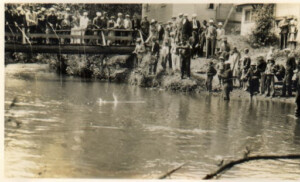Pringle Creek Fishing Was Great in 1911
What were fishing conditions in early Oregon?
Transportation problems limited our early fishing excursions to the home front. Pringle Creek, just east of Commercial Street, was the handiest place that yielded a good return for the effort expended.
There was a covered bridge over the creek at Commercial Street; underneath it was haven for crayfish, an excellent bait for trout. We would catch our bait and then move up the creek just to the rear of the Water Company buildings at Trade and Commercial Streets. A flume ran along the top of the bank, as it does today. Part of the water spilled into the creek over an apron at this point, and cutthroat trout, steelhead, and salmon congregated there on the spring migration.
Thirty fish was the daily limit of trout then, in 1915-1916. It was often possible for two of us to take two limits of trout there in one day’s fishing. When I became affluent enough, I acquired a split bamboo fly rod and a small reel – – one dollar for the rod, fifty cents for the reel, and 75 feet of enamel line completed the outfit. One day, after the trout quit biting, a steelhead hit my crayfish-tail bait and proceeded to take all my new line, breaking it off at the reel. That was my first experience with steelhead.
The first salmon of my career was caught where the Boise Cascade paper mill stood, a 15-pound spring Chinook. Hundreds of them ran up the creek each spring.

1928-05-27, Salmon fishing, north Mill Creek near Church Street. Crowd of onlookers. Men standing in stream with fishing poles., WHC Collections 1994.005.0025
Mill Creek was an excellent trout stream; Battle Creek was also a fine stream for cutthroat. In the spring, most every stream – – even ditches – – had cutthroat in good numbers. Croisan Creek yielded many a limit of cutthroat. The fish in these creeks would run from about ten to 17 or 18 inches long.
Farther from home, the Rickreal provided excellent fishing from its mouth near Eola to its source. In the fall, the Dolly Varden ran up this stream to spawn. During hop-picking time, the hop pickers at the Horst Brothers’ hop ranch added to the larder with Dollies that ran five to ten pounds or more. Some of us locals did likewise.
On one occasion, a fishing partner and I were headed for Buell Mill Creek. Getting over Butler Hill in a Model T was a major operation, so we decided to try Salt Creek at the foot of the hill. We got our limits there and went no further.
The Willamette River was a fine trout stream; it held cutthroat, redside (rainbow) trout, and Dolly Varden – – before pollution. The last trout I caught in the Willamette were two 22-inch rainbow about where Gerth Street would hit the river, sometime around 1922.
The Santiam River had the same species of fish as the Willamette, from the mouth to the source. In July, 1923, three of us caught two redsides in less that a half-mile of river just below Pamelia Creek, the first day we were there. These fish ran from about 12 to 24 inches long. One Dolly made 33 inches. That catch curtailed our fishing for the rest of our 10-day stay. After that, we caught only what we could eat. None was wasted. We built a small smoker and smoked most of that first day’s catch. We had only fished for a few hours that first day, and each of us went a different way and didn’t know what the total catch was until we returned to camp, or it would have been much smaller. That was before there was any road about Gates.
There was a so-called summer road as far as Niagara, and then a pack-trail from there. We rode the log train to Detroit and walked the 12 miles to our camp site. As always happens, once the road was built up to the Santiam, the fishing began to decline.
From a 1972 supplement to the Capital Journal newspaper, written by Paul Nicholson
This article originally appeared on the original Salem Online History site and has not been updated since 2006.







Leave A Comment